Your Cart is Empty
Customer Testimonials
-
"Great customer service. The folks at Novedge were super helpful in navigating a somewhat complicated order including software upgrades and serial numbers in various stages of inactivity. They were friendly and helpful throughout the process.."
Ruben Ruckmark
"Quick & very helpful. We have been using Novedge for years and are very happy with their quick service when we need to make a purchase and excellent support resolving any issues."
Will Woodson
"Scott is the best. He reminds me about subscriptions dates, guides me in the correct direction for updates. He always responds promptly to me. He is literally the reason I continue to work with Novedge and will do so in the future."
Edward Mchugh
"Calvin Lok is “the man”. After my purchase of Sketchup 2021, he called me and provided step-by-step instructions to ease me through difficulties I was having with the setup of my new software."
Mike Borzage
The Turning Point – Architecture after the Recession
August 27, 2014 6 min read
Editor's Note: This Guest blog post by Matthew Peek is part of our series of blog posts celebrating San Francisco's month long festival Architecture and the City. You can read the first two posts here and here. And don't forget to register for the next episode of How to Succeed in Architecture: Third Places – The Architecture of Sharing.
The views, opinions and positions expressed within guest posts are those of the author alone and do not represent those of Novedge.
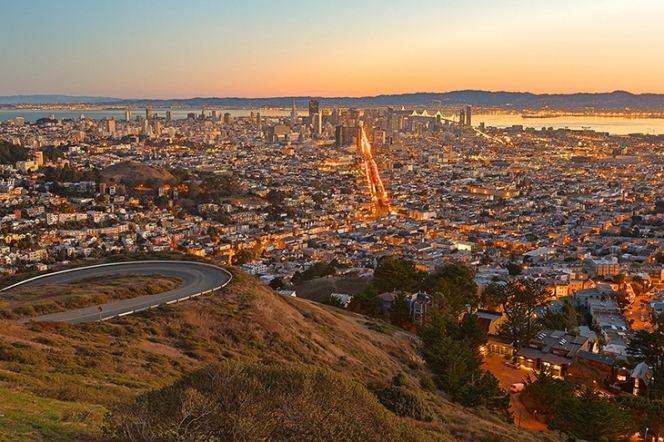
photo by Nicolas Raymond
"Your city is remarkable not only for its beauty. It is also, of all the cities in the United States, the one whose name, the world over, conjures up the most visions and more than any other incites one to dream." - Georges Pompidou, 1970
At the beginning of the 21st Century, as San Francisco emerges into a new architectural dawn, we appear to be one of the few cities emerging from the Recession with the possibility of achieving a place in history alongside the greatest of international cities. Our struggle with recovery, densification, and climate change has the potential to create a metropolis exceeding our very own expectations. But, you’ve heard the old adage, true only in part – “San Francisco is a great city without great buildings.” While we do have some greats, perhaps we need even more outstanding big buildings downtown, some real iconoclasts to break up the polite humdrum. I’m not going to impose a solution, but rather pose questions and comparisons gathered during a Fulbright in Europe.
Architecture and Democracy
When I met President Scalfaro upon arrival in Italy, he explained that, since the inception of democracy, the acquisition of capital was intended to serve the People and its government, not vice versa. His point directly related to my Fulbright in Architecture and Urban Design, which involved studying how the insertion of new high-performance public buildings could improve traditional communities. Through my work abroad, I concluded that the investment of big buildings brought enormous returns with the revitalization of surrounding historic fabrics and increased downtown pedestrian traffic. There were numerous details that made these buildings achieve their goals, i.e. generous plazas, reduced and/or subgrade parking requirements, and nearby metro lines. European politics consistently made great modern architecture work in dense historic contexts, with both local and foreign architects.
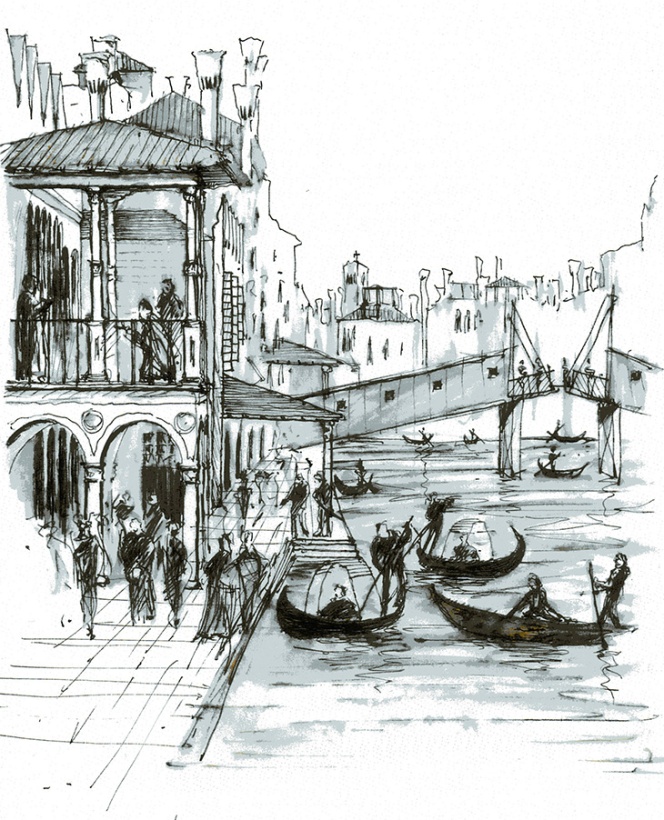
Fulbright Bridging, sketch by M. Peek
Against the background of my work, Europe was dramatically increasing the number of open architecture competitions to stimulate cross-cultural discourse, fueled by the EU's collective income. I began to realize that one of the central attributes of their success was this democratic leveling of the playing field. Seeing more opportunity in Europe as an emerging professional, I stayed for five years after my Fulbright. I began by entering competitions with a young group of architects – we were often shortlisted in the top three, something inconceivable back home, placing above of hundreds of entrants, a majority of whom were Starchitects. Within a few years, our recognition led to the construction of a series of major avant-garde public buildings, and we modernized the office with an array of new high-tech computers. We discovered that the right balance of intuitive software enabled a small team of architects to do the work of over a hundred. Of course, as a San Francisco native I would inevitably return to the inescapable allure of our city perched on the edge of the world, teeming with innovators.
Leveling the Playing Field
If San Francisco now holds the capital and power to make great urban architecture, then what is holding us back? Is it the public review process, or the architectural process itself? Architects tend point the finger at the lengthy approvals, EIRs and NIMBY, and sometimes it goes too far, I have even read, and I quote, that the “democratic process” is itself at fault. Is it? Wait a minute… aren’t London and Paris centers of democracy, don’t they have great modern buildings, and, aren’t their approval processes just as complex? Are the very ideals of our own political foundations really to blame, or is it quite the opposite set of politics that currently dominate the design of buildings? Of course, there are good designs selected through every process under the sun and we should maintain this diversity, but, why not learn from the success of other nations and bring back the open competition, thereby leveling the playing field? These forums could offer citizens a comment period from the outset, rather than block a project after designed, transforming citizens into stakeholders. In Europe, public competitions are widely published in popular journals, engaging the public in the architectural discourse and creating a collaborative atmosphere of design, not to mention returning a little celebrity back to the world of architecture.
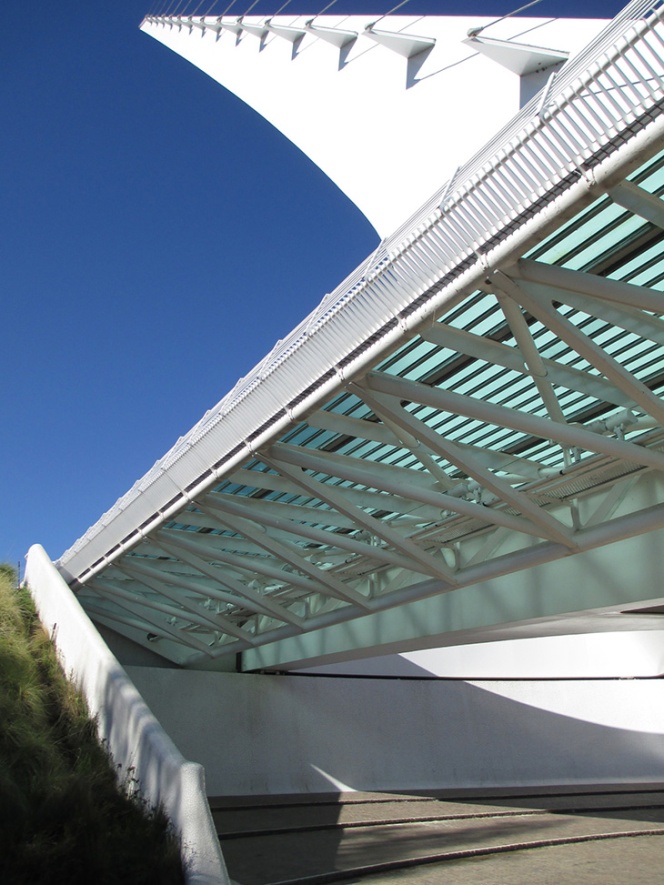
Sundial Bridge, photo by M. Peek
Another avenue to explore is architectural education itself, i.e. while we focus our students on design, what is it? Should it be limited to presentation drawings, or should it broaden to include a wider intellectual approach, ranging from the cultural foundations of language and politics to how they are concretized through the building process? Many other countries do not see the architect as only an artist; instead educate students to become intellectual leaders. In addition, they use the two-part documentation setup of a design architect with a local construction architect. Both offices are proud of their work, since, from the outset, universities teach students that they can successfully choose either path, i.e. one is not better than the other and they are all master builders.
The City as a Work of Art
Unlike many cities, San Francisco’s most revered icons are revivalist, as if we need to depend on some distant land for stylistic guidance. When I read Wright as a student, I understood why America needed great architects, that we deserved new forms approaching the ideals of our very own democracy. When I discovered Corbusier, the argument thickened, and I sensed the immediate need for architecture to elevate itself to the accomplishments of American industry, the majesty of our ocean liners and proud factories. The old adage has perturbed me ever since – if San Francisco is one of the most beautiful American cities, then why don’t we have even more great buildings?
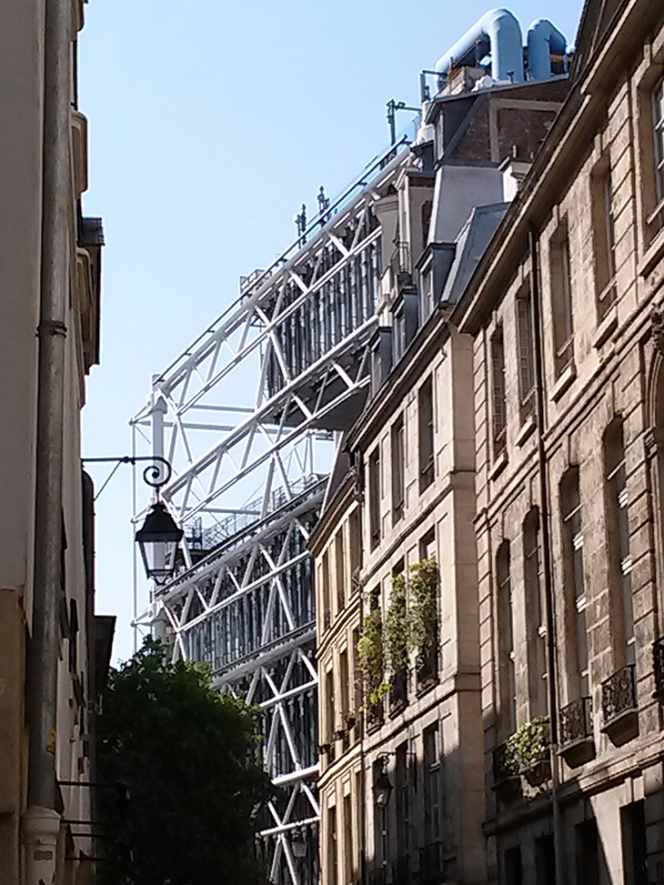
Parisian Plug-In, photo by M. Peek
When I returned from my Fulbright, fantastic changes were underway: our elegant modern airport soared with skyways to a gleaming downtown, where the grand new Ferry Building stood proudly, overflowing with pedestrians, a testament to the success of big buildings as anchors for healthy urban growth. But, when it came to cultural institutions, the most important new museums had been banished to a distant park, best reached not by foot or public transit, but by the ubiquitous automobile. Fortunately, the success of the new Embarcadero had ushered in an expanded network of pedestrian promenades linked by mass transit. The subsequent Manhattan High Line competition also set a standard for big urban projects, stimulating a thirty block long renaissance, jumpstarting the construction of several major buildings along this pedestrian paradise. Like New York, we were aiming for the stars, with proposals including a Transbay Terminal by Richard Rogers, then a downtown building by OMA, a new skyscraper by Renzo Piano, and, in Berkeley, a museum by Toyo Ito! Groundbreaking new architecture and urbanism! However, none of these world-class projects were ever built as local politics and the Recession took their toll. At least the town of Redding built a Calatrava bridge, one of the most beautiful structures in California. Perhaps the economic pause would give us time to reflect, time to invest in a heightened public awareness of architecture – doesn’t everyone know that just one new building, lasting generations, could cost the same as one major sporting event?

High Line Plug-Ins, photo by M. Peek
Urban Visionaries
On a recent trip to Paris, I fell in love with its monuments as if visiting for the first time – its bold urban insertions, ranging from the now everyday icon of the Eiffel Tower to the iconoclastic Pompidou Center. The architectural avant-garde had been realized forty years ago in Europe through an open competition: with their willingness to risk all, young Piano and Rogers had set a bold new course for big urban buildings. I realized this would have been impossible through our current Kafkaesque architect selection process, closed to the public, which feels utterly un-American and anti-innovation, fundamentally erasing our own cultural identity that is based on the potential for David to confront Goliath through creative thinking, self-reliance, and the will of the small group to succeed through independent thought. While the Pompidou Center may have been a little over the top like all groundbreaking achievements, it definitely didn’t emerge out of mediocrity and became one of the most exciting spaces in Paris, an exoskeleton years ahead of its time, something we are only achieving today with advanced computing technologies. Without such a unique vision achieved through the democratic process, great city centers may have taken another hundred years to evolve, forever stuck in a backwards spiral of nostalgia and corruption, a romanticized memory of what was; not what history actually gives us, an enlightened framework for moving forward, buoyed by the human spirit.
Matthew Peek is the Co Founder and Principal at Peek | Ancona Architecture. He was also a panelist on the 11th episode of How to Succeed in Architecture: Resilient Architecture.
Related articles
Also in NOVEDGE Blog
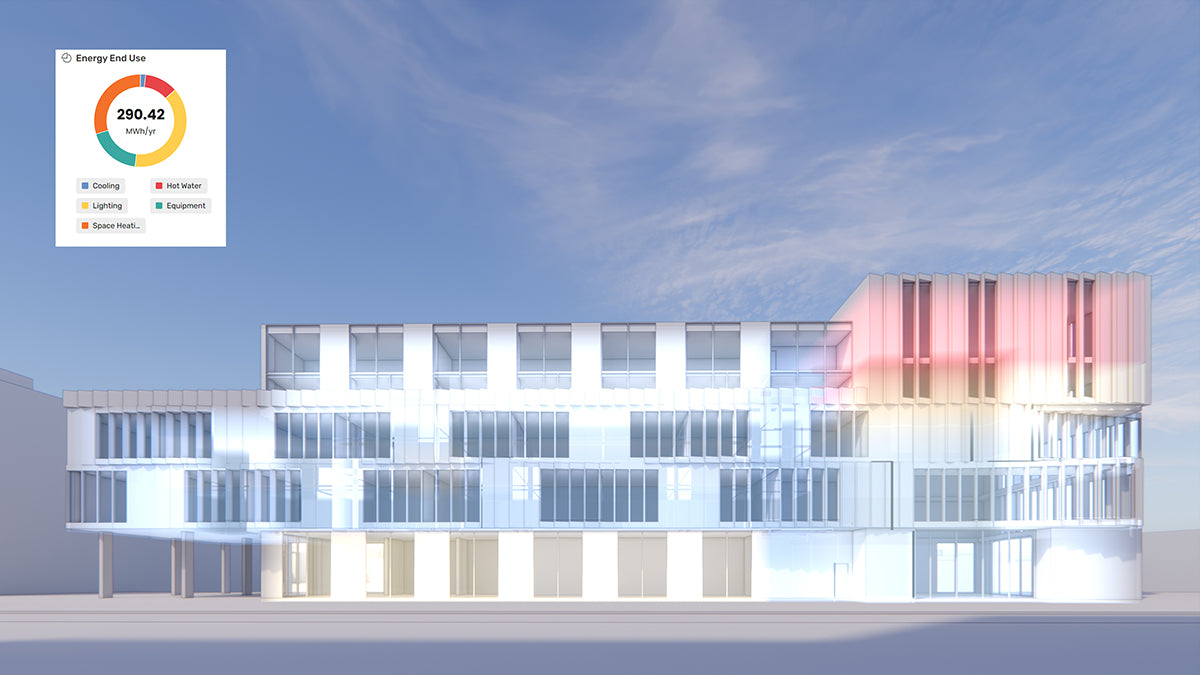
How the AEC Industry Shifted Towards Essential Sustainable Building Design
August 15, 2024 4 min read
Read More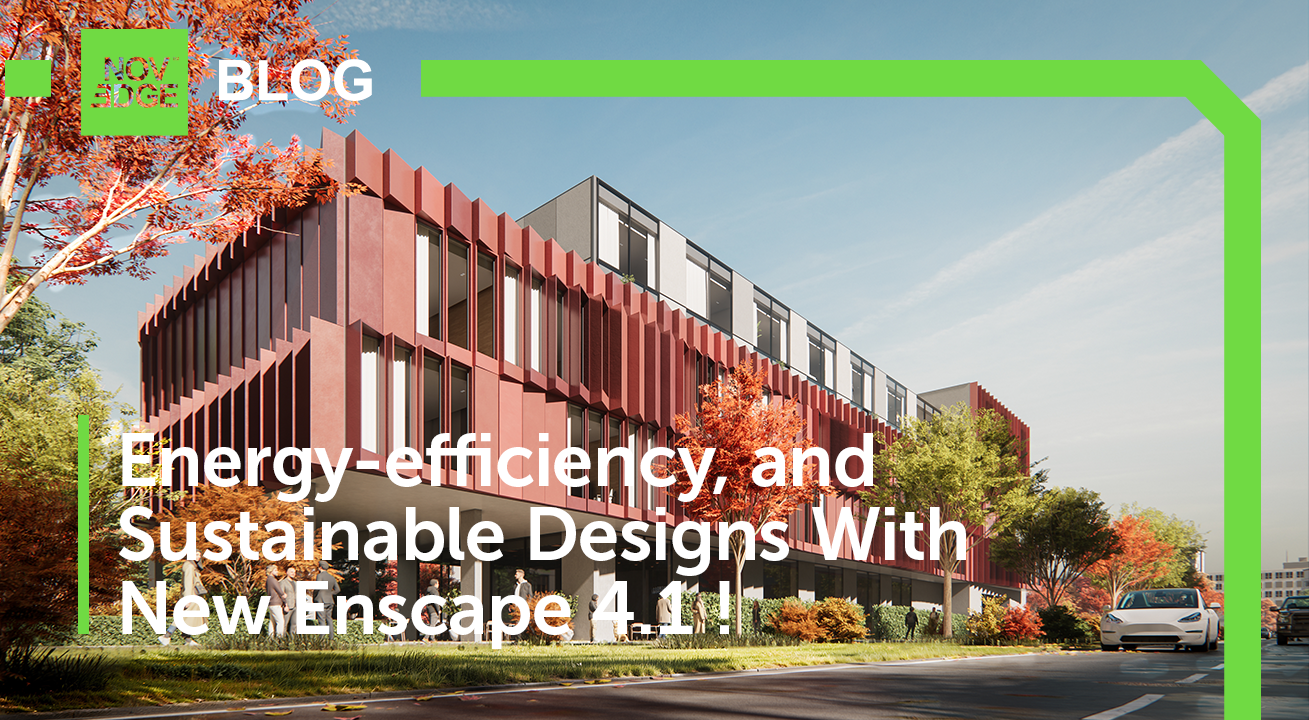
Unlocking New Realms of Design with Enscape 4.1: Introducing Impact Add-on and Lot More
August 02, 2024 2 min read
Read More
Explore Autodesk Revit 2025.2: New Features and Enhancements for Enhanced BIM Workflows
July 30, 2024 3 min read
Read MoreSubscribe
Sign up to get the latest on sales, new releases and more …





